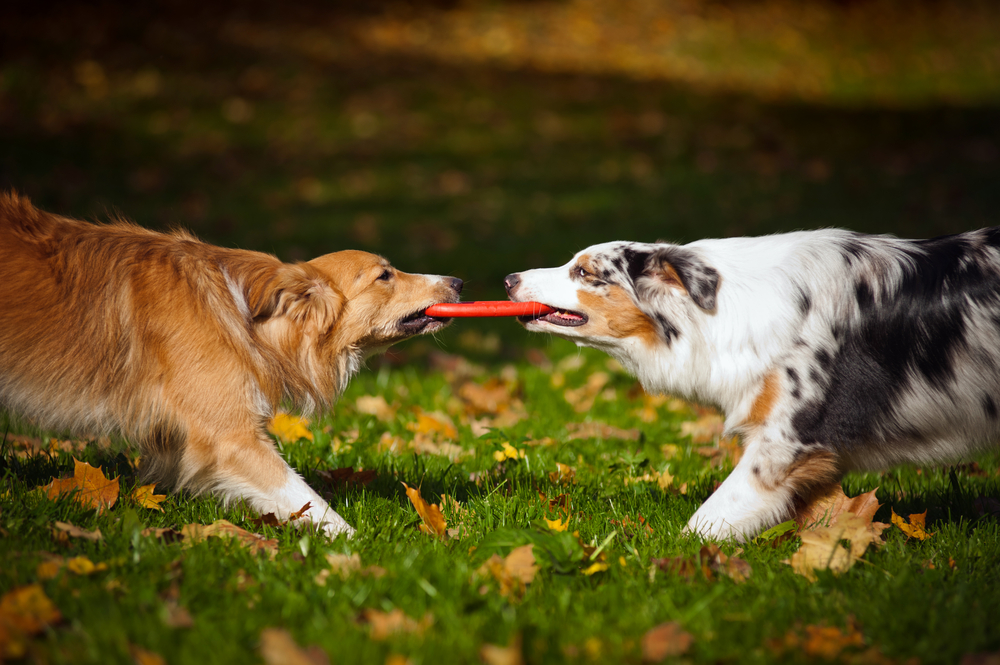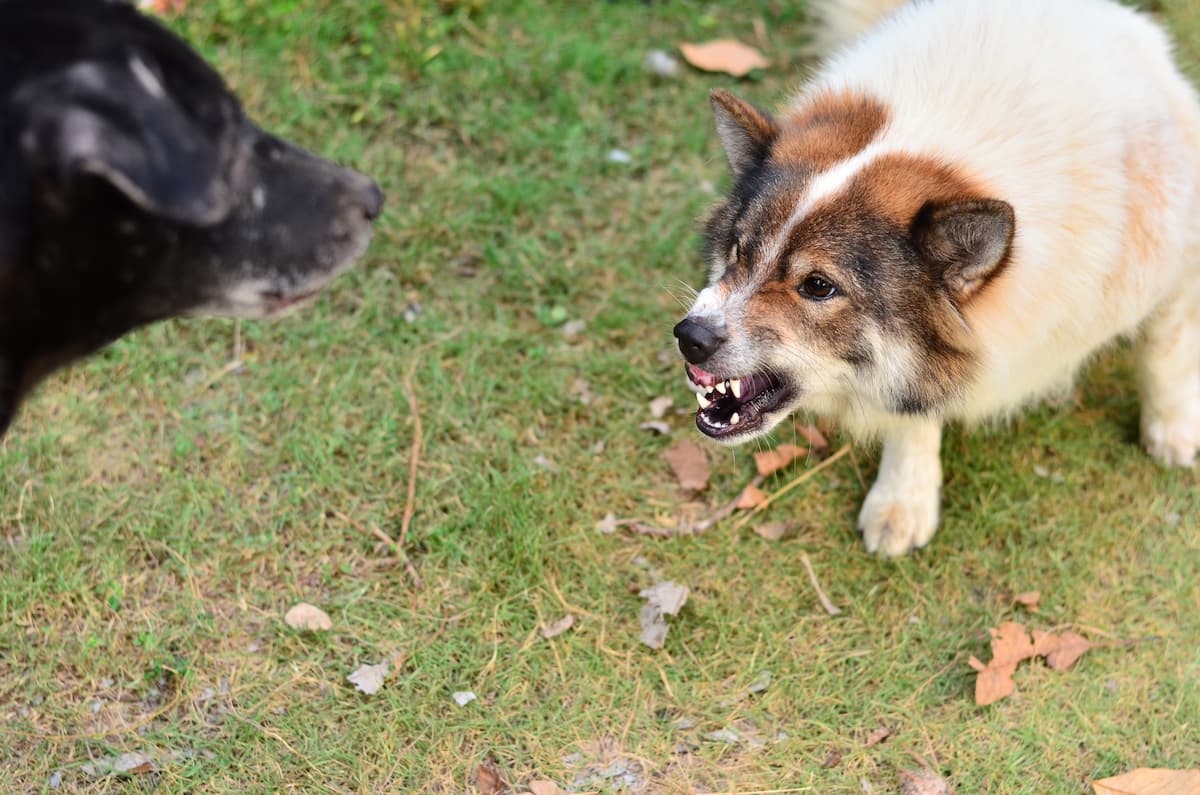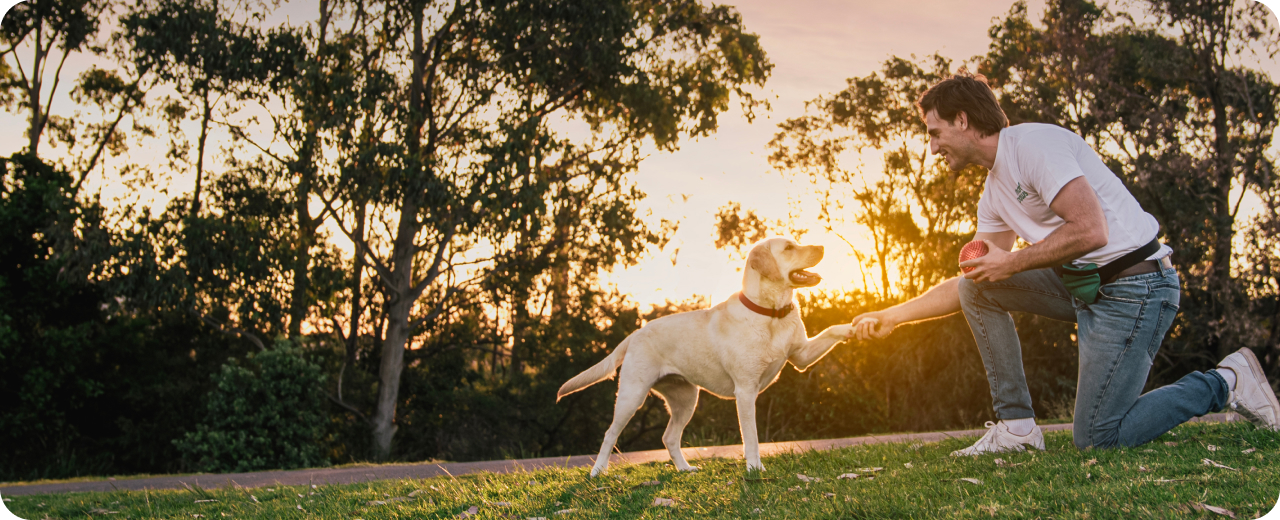Finding the right balance between normal, fun play and overly rough play between dogs can be tough. As a loving Pet Owner, should you allow your doggo to navigate the intricacies of canine communication on their own? Or, is it better to follow your gut and break up the banter before it goes too far?
To be sure, the stakes are high. After all, you would much rather your pupper’s pet insurance cover things like regular check ups than emergency stitches. But, you also don’t want to overly limit your dog’s play or make them fearful of all interactions with other dogs.
Don’t worry, there is a way to find a middle ground that you and your pup can be happy with. In this article, we’ll give you the tools you need to be a brilliant dog park referee!

First, what does normal dog play look like?
As long as your dog is up-to-date on their vaccinations and not suffering from any injuries that could make play unsafe, they can benefit from regular play sessions with other dogs. The first step in setting your dog up for success is to familiarise yourself with appropriate play. Here are a few common elements of happy play, identified through dog body language:
- Play bows. The play bow is a universal sign that dogs use to initiate a play session. It’s an adorable and obvious signal in which your dog drops their front forearms to the ground and sticks their wagging tail in the air. If you see the play bow, you can be sure that your pupper is having a good time with their playmate.
- Physical contact. Shouldering, pushing, jumping, pawing, hip bumping and even rolling each other over are all common play practices.
- Running and chasing behaviour. Some dogs absolutely adore being chased or chasing their furry friends. It can be a bit off-putting, since it can look like a hunting behaviour, but in a healthy play session, all dogs are having fun.
- Biting. Play biting or nipping around the legs, ears, neck and face is a very normal part of pupper playtime, although it often raises our red flags when we see it. In reality, though, these bites should be controlled and non-aggressive so that no one gets hurt.
- Growling and barking. Some dogs make a whole lot of noise when they play, especially if they’re very invested in the game or are full of energy. Playing is a great outlet for vocal dogs, and the more time you spend with your pup, you’ll learn to recognise the sounds they make when they’re having fun.
- Taking turns. Some dogs always want to play the role of being chased at the dog park (we’re looking at you Shiba Inus!) but most will reverse roles at various times throughout the session. It’s not always a 50/50 split, but you should notice at least some back and forth. This is a good sign that the dogs are evenly confident in the game.
- Looping back. Now, this is one of the most important elements of a positive, equally-matched play session. If your dog is enjoying the game, they may break away for a moment to rest or do a quick check in with their beloved Owner before diving back into the play session. Short breaks are a way for dogs to manage their excitement levels and keep play from going too far.
Keep in mind that every dog has their own play style and not all of the elements of normal play will apply to them. But in general, you should be able to identify at least some of these signs that your doggo is having a good time.
In the next section, we’ll cover some of the signals that your pupper’s play is not all tail wags and smiles.
What are the signs of overly rough play between dogs?
As you might have noticed when reading the elements of normal play, roughhousing between dogs is really a form of friendly fighting. And that’s exactly why we humans might struggle to find the line between what’s appropriate and what’s dangerous. Here are a few red flags that could indicate that a pair is mis-matched and requires intervention:
- There is no role reversal. Again, some playful pairs won’t reverse roles, but the majority do. If one dog is consistently the top dog or initiator, it could overwhelm the other.
- One dog is actively trying to escape. Remember, normal play has an occasional break so that both pups can catch their breath and manage the excitement level of the game. In an overly rough play session, there will be no breaks and one dog may be looking for an escape route.
- Fearful or aggressive body language. Tucked tails, ears flat on the head, lip curling, and stiff body movements are all indications that an interaction is boiling over into aggression.
- Ganging up. In some cases, it might be appropriate for one dog to lead a rambunctious game of chase. But more often than not, big groups ganging up on one dog is an indication of an unsafe escalation.
- Yelping or crying. If you hear your dog crying, whimpering, or yelping, take that as a clear sign that one dog is not happy with the play session. It’s time to step in.
 What can you do if your dog is on the receiving end of overly rough play between dogs?
What can you do if your dog is on the receiving end of overly rough play between dogs?
Now that you know the difference between normal play and overly rough play between dogs, you’re in a much better position to decide when to intervene.
In most cases, the roughness will dissipate when you interrupt the play session. And there are a couple of ways to do this. In the early stages of overly aggressive play, you might be able to call off your dog and have them come to you. This will give the other dog a chance to take a break and maybe even find a more appropriate play partner.
If your dog is not responsive to your calls because the play has gone over the line, you can physically step in and remove your dog from the play session. Now, we want to be very clear that this is not an appropriate move for dogs in the middle of a fight, as that could result in serious injury. Only physically intervene if the overly rough dog is still in play mode, otherwise, you’ll want to rely on other tactics to break the dogs away from each other, such as using loud noises.
Ideally, you’ll be able to involve the Owner of the overly rough dog in this situation. If they can harness the attention of their pup, you’ll be able to safely leash up your dog and remove them.
After a situation like this, you might find that your dog shows signs of anxiety around the dog park. It will be extremely important to give them more opportunities to play with dogs who share their energy levels so that they don’t develop an aversion to dogs in general. If the dog park is full of overly rough puppers, try scheduling one-on-one playdates with dogs who are a little less assertive.
Is your dog the one to up the ante? Here’s how to encourage them to play nicer
Let’s say that your doggo is the one who is constantly causing chaos at the dog park. If this is the case, there are solutions, such as:
- Work on basic training. On the one hand, obedience training will be necessary when you need to regain your dog’s focus while they’re playing. But, it’s also a great opportunity for mental stimulation. If they get regular interaction with their beloved Owner, they may have less pent-up energy when they get into contact with other dogs. Make sure to have lots of dog treats on hand so that your pup associates you with delicious rewards for good behaviour.
- Exercise your dog before they interact with other dogs. Speaking of pent-up energy, exercising your dog immediately before a play session is a fantastic way to avoid overly rough play. It may seem counterintuitive, but it will only be temporary until your dog has learned proper doggy manners.
- Schedule one-on-one training sessions with other dogs. Until you know that your dog has learned to dial it down when it comes to play, you’ll want to press pause on high energy environments like dog parks and dog beaches. Instead, schedule a playdate with a well-socialised dog who can teach them about appropriate play. Make sure to supervise the entire time and remove your dog when they get overly excited.
- Be proactive with breaks. As we’ve mentioned, playtime breaks are a great way to reset the energy level of a play session so that things don’t get out of hand. If your dog struggles with pumping the breaks, you can step in periodically and call them away from their play session. When they’re calm, allow them to continue playing.
- If your dog struggles with reactivity or aggression, call in an expert. The previous steps are fine for a playful dog who is a bit too rambunctious at the dog park. If, on the other hand, your dog is acting out aggressively, then another approach will be necessary for their safety and the safety of other dogs. A professional dog trainer or behaviourist can help, but in the meantime, use extreme caution around other dogs.
 Your doggo is ready to romp around with their furry friends!
Your doggo is ready to romp around with their furry friends!
So, we’ve covered everything you need to know about safe versus overly rough play. Whether your dog has been on the receiving end of a rough & tumble encounter or is the one with the not-so-friendly play style, there are steps you can take to make each doggy encounter successful.
Have you dealt with overly rough play between dogs with your pooch? We’d love to hear your tips for keeping those tails wagging at the dog park!
Need the help of a Dog Trainer?
Need help identifying rough play in dogs and just down right aggressive behaviour? Or need an expert to give your four-legged friend some obedience classes? Find a Dog Trainer near you that can help teach your dog a range of commands, including helping with socialisation – so the next trip to the dog park is more enjoyable for everyone!
